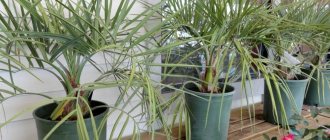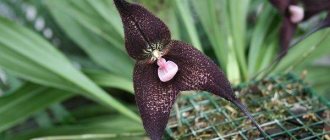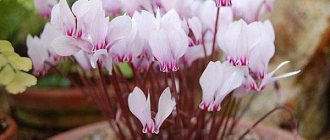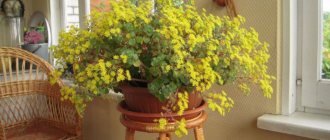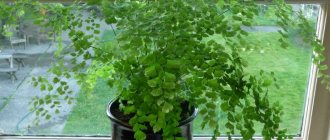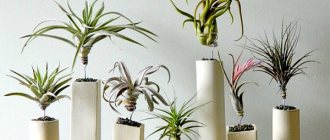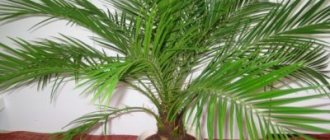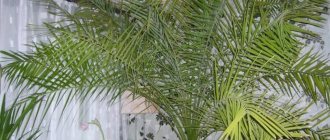Description of the plant
The home palm tree is associated with serene relaxation and warmth. The genus of palm trees has more than 3,000 varieties. In the wild, the palm grows up to 10 meters or more in height. In a temperate climate, the plant does not survive in open ground, so they are grown indoors. Decorative culture is unpretentious.
There are many types of palm trees to grow at home. Varieties differ in shape and growth rate. The leaves can be in the shape of an umbrella, fan, or fern. The ground part is lush and voluminous. According to the shape of the leaf blades, palm trees are divided into fan and pinnate.
The latter type is distinguished by the parallel arrangement of leaves, which are attached to the central petiole. Fan palms are distinguished by the fact that the leaves are attached to the petiole at one point. The trunk of a palm tree can be single or branched. Based on this characteristic, plants are divided into shrubs and single-stemmed ones.
At home, palm trees can gradually change.
Hamerops squat
The botanical name of this palm species is Chamaerops humilis. Came to Europe from Africa. It has been cultivated in greenhouses for over 300 years. This is a bush-like palm with several trunks 2-3 m high, growing from a common base. In the Sochi arboretum of the Research Institute of Gorlesecology there are specimens that have 7-10 or more trunks in a bush.
It is not recommended to separate the side shoots of Hamerops, since they are not suitable for vegetative propagation.
The palm tree grows slowly. Over the summer it forms up to 7 leaves, which usually live for 7 years. Blooms in May-June. The fruit is a drupe and ripens in November-December.
The palm tree is drought-resistant and undemanding to soil. Propagated by seeds.
Seeds do not germinate in the pulp of the fruit. After removing the pulp, they germinate for 2 months at room temperature. Removing the cap causes accelerated seed germination in 11 days.
Indoor palm tree photo and name
The palm genus has many varieties. Only certain species are grown indoors. Tropical palms differ in shape and are unpretentious. More often, gardeners grow cat palm, Asian palm, Rhopalostis, Washingtonia, Gioforba, Brachea, etc.
Areca
Areca is a plant with thin cylinders emerging from a tubular base. The leaves are pinnately dissected. The inflorescences are shaped like cobs, with male staminate flowers at the top and female pistillate flowers at the bottom.
Areca bears fibrous berries from which seeds are extracted.
Brachea
Brachea is an evergreen palm with fan-shaped leaves. Toward the bottom, the base of the trunk thickens and can reach a diameter of 50 cm.
Scars appear on its surface below, which form after the foliage withers.
The leaves are hard, located in the upper part of the trunk, have a bluish-gray color and thin petioles covered with thorns. During the flowering period, many inflorescences are formed on the palm tree, the length of which reaches about 1 meter. They fall from the top of the tree to the ground. The fruits are round, single-seeded, brown in color. Their diameter is no more than 2 cm.
Bhutia
Butia is distinguished by petioles that are shaped like arcs. They can reach from 2 to 4 m in length. Each leaf contains 80-100 pairs of narrow lobes, shaped like swords. Their length reaches 75 cm. The upper part of the leaves is bluish-green, the lower part is slightly paler. The petioles are covered with thick felt in young palm trees. In mature plants, the felt turns into small spines.
After the leaf blades die, brown stumps remain on the trunks. After the stumps fall, peculiar scars remain on the trunk.
Butia blooms at the end of spring, releasing spike-shaped panicles from the axil of the upper leaf.
The length of the inflorescence is 1.4 m. The flowers are light red. The fruits are oval-shaped and have a fragrant aroma. Ripens at the end of September. The fruits are edible, suitable for canning, for making liqueurs and jellies, and eaten raw.
Kariota
Kariota stands out among other types of palm trees due to its non-standard leaves. They are large and asymmetrical.
The palm tree is an evergreen species. In nature, its height can reach 20 m, but when grown at home - from 1 to 2 m.
Karyote can be tree-like or grow in the form of a bush. The leaf blades are double pinnate, in the form of original wide feathers of irregular triangular shape. The top of the leaf blades appears to be torn off. Their edges are unevenly jagged. The foliage appears light and airy thanks to the long petioles.
Kariota does not bloom at home.
Washingtonia
The Washingtonia palm genus belongs to the Arecaceae family. In nature it grows up to 25 m with a trunk up to 100 cm in diameter. Fan-shaped leaf plates grow at the top of the plant. The length of the cutting, covered with thorns directed in different directions from the trunk, is 1.5 m. It rarely blooms when grown indoors.
Washingtonia leaf fibers are used to weave baskets. The fruits are suitable for making flour. Washingtonia needs coolness and plenty of space.
It is rarely grown at home, as it increases significantly in size and requires planting in open ground.
Giophorba
The palm tree is distinguished by its unusually shaped trunk in the form of a vessel. The surface of the trunk is smooth, thickening in the middle. The narrow part of the trunk can reach 15 cm in diameter, and the wide part - 40 cm. The height of the tree does not exceed 1.5 m.
The foliage is bright green, fan-shaped, pinnate. It consists of 30-40 pairs of leaves, which are shaped like feathers. Their length is no more than 40 cm.
Hovea
When grown indoors, Howea grows up to 3 m. It produces no more than 3 leaves throughout the year. In nature it grows up to 15 m. The plant is single-stemmed. The upper part is formed by stems with dissected, pinnate leaves. It forms many basal shoots, which are later united into a common trunk.
Zamia
Indoor Zamia palms are evergreens. They grow small. The trunk is smooth. Most of it is located underground. It is distinguished by a tuberous elongated shape. The pinnate leaves are alternately arranged on long stalks, but are not particularly dense. The petioles are occasionally covered with spines. The leaves themselves are hard, dense, divided into several parts. They are distinguished by their lanceolate shape and jagged edge.
Liviston
This variety grows up to 25-40 cm. It is classified as slow-growing. The trunk is gradually covered with dried petioles, which remain after the foliage withers and further dies.
The crown is formed from fan leaves at the top and has a rounded shape. The leaves are dissected to the middle. The formed parts of the leaf plate are radially folded. The length of the petioles is no more than 0.2 m. Inflorescences are formed in the axils under favorable conditions.
When grown indoors, this type of palm tree does not develop a trunk.
Likyala
This is a dwarf palm. In its appearance, this flower bears little resemblance to a palm tree. In nature, the height of the plant does not exceed 3 m. Large Likuala is grown by flower growers. It features beautiful pleated leaves. The leaf blades are round, bright green, and resemble fans. The width of the leaves of an adult plant is up to 1 m.
The leaves of this variety are used in making hats.
Good to read: Croton is a capricious beauty with extraordinary foliage.
Has a thin trunk. The fruits are large in size and hang in clusters. When grown indoors there is virtually no color.
Rapis
Among the palm trees for the home, Rapis is distinguished. Flower growers grow two varieties. Usually this is Rapis low. It stands out for its unique appearance and small size. Grows up to 1.5 m.
The second variety, Rapis tall, is grown for large areas: greenhouses, supermarkets. Grows up to 3 m.
Ropalostylis
This palm tree has a slender trunk. After the leaves fall, rings form on the trunk. Belongs to fruit-bearing species. The fruits are small, round in shape, red in color. Mature plants can be 10 to 12 m tall. Flower growers grow this variety only when young.
Important to know: The fruits of Chinese lemongrass have tonic properties and are very beneficial for the human body.
Sabal
The Sabal palm genus has 16 varieties. In the wild it grows up to 30 m with a trunk diameter of up to 0.6 m. The foliage is fan-shaped, evergreen, supported by strong petioles.
Trachycarpus
In nature, a palm tree of this species can grow up to 20 m. Its trunk is covered with fibers of dead leaves. When grown indoors, the height of the plant does not exceed 2.5 m.
The leaf blades have an oblong, round shape. They can reach 60 cm in diameter. The petioles of the leaves are long, covered with spines. The leaf plate is divided into segments. There is a pale bluish coating on the reverse surface.
The inflorescences are racemose and consist of female flowers. In plants grown in winter gardens and greenhouses, after flowering, clusters with fruits resembling grapes are formed.
Trachycarpus does not bloom when grown indoors.
Good reading: Flowering indoor plants: catalog with photos and names, recommendations for growing.
Date
In the wild, the date palm reaches 30 m. Its fruits, dates, have a sweet taste.
Therefore, the date palm is grown on an industrial scale. Sugar is made from the sap of the plant.
Its distinctive feature is its slow growth. With proper care at home, the date palm grows up to 2 m, but grows very wide. Culture requires a room with high ceilings and a large area. The leaf blades are pinnate. Palm leaves are the main decoration of the plant. The inflorescences consist of yellow buds. The photo of these domestic palm trees is striking in its unusualness.
In indoor conditions, the date palm practically does not bloom and does not bear fruit. The plant produces its first fruits after reaching a height of 15 m. This is impossible at home.
Hamedorea
A bush variety of Hamedorea is grown at home. There is a palm tree in the form of a vine or bush with one stem. It grows slowly. It produces 1-2 leaves during the year. Plants can be female or male. The main difference is the inflorescences. Female buds are orange or deep red, single, male buds are red or yellow, collected in inflorescences. Plant grown indoors will not bloom.
Hamerops
The genus of this plant is represented by only one species. The tree grows up to 4-6 m. It blooms in April, May, June. The Hamerops palm plant is distinguished by its spiny petioles and massive trunk. The leaves resemble fans.
Read about which plants are similar in appearance to palm trees here.
Frost-resistant
There are few palm trees that can withstand frost. These are heat-loving plants by origin. But still there are some.
Let's take a closer look at these varieties with photos and names.
- Brachea is one of the favorite gardeners to grow at home. Grows quickly. It has fan-shaped, lush green leaves. It is easy to care for and can withstand temperatures down to -8 degrees.
- Trachycarpus is one of the most frost-resistant, can withstand short-term frosts down to -23 degrees and permanent frosts down to -10.
- Wshingtonia filamentous - can grow in cold, unheated rooms and tolerate temperatures dropping to -5-8 degrees.
- Sabal - different species tolerate frost from -10 to -20 degrees.
- Butia - can withstand temperatures down to -12. At a frost of -14, the leaves freeze, but it does not die.
Palm tree care at home
Planting and caring for a palm tree is not particularly difficult. Whenever possible, palm trees are planted in winter gardens. Optimal conditions for house plants are created here. When purchasing an adult seedling, the risk of disease and death is taken into account. Sudden changes in the environment have a detrimental effect on the plant. However, it will not be difficult to grow a palm tree from a small sprout.
The genus of palms belongs to hydrophilic plants. In nature, they grow near water sources. The main feature is that even in severe drought they can exist for a long time without moisture.
Although the plants do not require special care, when growing at home, few people have seen a palm tree bloom. They rarely produce inflorescences and bear fruit even less often. The Asian palm and date palm do not bloom at all, because this is due to their physiology.
Watering
Palm trees need to be watered promptly and often. The soil should not dry out. In the winter months, the amount of watering is reduced. At this time, the soil is moistened once every 2 days. In summer, palm trees need to be watered daily.
If the temperature in the room where the seedling is growing does not exceed 7 °C, watering is carried out 2 times a month. If necessary, spray the above-ground part instead of moistening the soil.
It is recommended to make drainage at the bottom of the pot so that the moisture does not stagnate.
Settled water is used for irrigation. After moistening, the soil must be loosened.
Top dressing
Indoor palm trees need fertilizer to form healthy roots and grow green mass. The main components of the additives are phosphorus and nitrogen. Fertilizers can be purchased ready-made in specialized stores and used according to the instructions, for example, “Green Paradise”, “Kristalon”.
You can prepare the fertilizer yourself. The simplest option: make a solution from a tablespoon of wood ash and a liter of water. The product is used throughout the growing season at intervals of 7-10 days.
Weakened plants are fed with a solution of dry yeast.
To do this, dissolve a tablespoon of yeast in a liter of water and leave for an hour. The finished product is diluted with 5 parts of water and watered over the plants. Potato starch is used using the same method. It is also recommended to use chilled potato broth for watering, which is formed after boiling the root vegetable.
Orange and banana peels are used for feeding. They are mixed with a few teaspoons of sugar and poured with water, keeping the proportion: 2 fruits per 3 liters of water. The solution is infused for 3 weeks in a dark place. The finished products are filtered and diluted with water in a ratio of 1 to 20. This fertilizer is used to water the plants once a month.
Temperature
Ornamental palms thrive at temperatures from 16 to 22 °C. In winter, this figure drops to 8-10 °C. Asian palm, coconut, Hamedorea, Areca and other heat-loving species are kept in winter at temperatures from 14 to 16 ° C.
Trimming
Leaves of indoor palm trees are not trimmed. This can lead to plant disease.
Only yellowed and dried leaves are removed. With normal growth, palm trees turn yellow and only the lower leaves wither. If this happens to the top ones, the plant is not being properly cared for or is sick. It is not recommended to shape or shorten the crown, since palm trees have only 1 growth point. If interfered with, the plant may die.
Transfer
It is recommended to replant the palm tree in the spring. These plants require nutritious soil. The substrate can be purchased in specialized stores or prepared independently. Composition of nutrient soil: 2 parts each of clay-turf and humus-leaf soil, 1 part each of peat, humus, sand, a small amount of wood ash.
Young plants, no more than 3 years old, are replanted once a year. An adult indoor palm tree needs to be replanted every 3-5 years.
A drainage layer is made in the pots. The material is mixed with charcoal. When replanting, monitor the roots of the plant so as not to damage them. When removing it from the old pot, they try to remove the root system along with the earthen lump.
Palm trees require tall pots.
After transplantation, the plants must be fed. To do this, use organic additives necessary for better rooting and further growth of seedlings.
Reproduction
The domestic palm tree is capricious when propagated indoors. Plant seeds are sown in February or March.
Purchase planting material from specialized stores.
If the seeds were fresh, shoots will appear within 20-30 days. Otherwise, seedlings will appear after 2-4 months.
The seeds are poured with water, preferably warm, and left for 3-4 days. If the planting material is large, it is trimmed. Small pots are required for sowing seeds. Planting material is deepened in them by 2-3 cm. The distance between plantings should be at least 3 cm. Seeds are germinated at a temperature of 20-22 or 28-30 ° C. It all depends on the variety.
The soil must be moistened and covered with film. The container is periodically opened for ventilation and watering. When the seedlings grow to 10 cm, they are transplanted.
You can also propagate a bush palm tree at home using the root method; for this, the tree is removed from the ground and a sprout with a complete root system is separated from it. The cut is made with a sharp knife and subsequently treated with crushed activated carbon. The new plant is planted in a separate container.
Pests and diseases
The palm tree reacts to improper care. This is manifested by deterioration in appearance or various diseases.
Excess or lack of moisture leads to yellowing of the foliage. The above ground part may turn brown.
When the air is dry, the tips of the leaf blades begin to dry out. With high humidity, fungal diseases appear. They appear as spots on the leaves. To combat fungal diseases, remove the affected parts, reduce the temperature, and reduce the amount of watering. If fungal spores are in the soil, the palm tree is replanted. At the same time, treat both the plant and the soil with fungicides.
The most common disease of palm trees is root rot. When affected by it, the plant does not develop and practically does not grow, some sections of the roots die off, and the above-ground part turns yellow. The affected areas are removed, and the roots of the plant are placed in the “Chomecin” solution. After 15 minutes, the treated areas are sprinkled with activated carbon, and the plant is replanted.
Mealybugs, scale insects, and spider mites are considered dangerous pests for palm trees. To control pests, plants are treated with insecticides.
Where is your homeland?
The tropics and subtropics are considered to be the homeland of the palm tree. These zones are the native habitat of trees. Where do they usually grow? Most often they can be found in Africa and Eurasia, as well as some regions of Central Asia.
The plant has become widespread in many regions of the globe. They are more often found on the shores of tropical seas, high in the mountains and in humid forests. A huge number of species grow in Colombia and Madagascar. The fan palm is more common in Spain. The feathery representative can be seen more often in Greece.
Also, some species grow in the territory of the former Soviet Union, for example, on the southern coast of Crimea.
You can see what a flower in the form of an indoor palm tree looks like in the photo here. Howea Forster
Hamedorea
Rapis
Brachea
Washingtonia
Giophorba
Kariota
Liviston
Hamerops
Yucca
Date palm
Sabal
Trachycarpus
Castor bean: common varieties, planting and care features
Castor bean is an annual ornamental deciduous spreading plant Castor bean is an annual ornamental deciduous spreading plant up to 10 m high. The name is associated with the shape of the seeds, which resemble an insect that has drunk blood. Due to the decorative value of the huge palmately divided wide leaves on long petioles, the crop is widely used in landscape design. For industrial purposes, the crop is grown for its seeds.
Classification by appearance
According to their habit (appearance), all species can be combined into 2 large groups - single-trunk and bush-like .
Single-barreled
Single-stemmed Trachycarpus Fortune palms near the laboratory building in the Garden. Photo by the author
Bush-like
In these palms, the bush-like shape is formed by adventitious trunks. In the south of Russia, one of the most common representatives of this group is Hamerops low. Even when frozen, it quickly recovers.
Chamerops low is a bushy palm. Photo by the author
